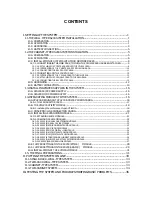
Chapter 39 Product Specifications
X2002 User’s Guide
504
The following list, which is not exhaustive, illustrates the standards supported in
the X2002.
Call Detail Record
The X2002 can generate call detail records and send them to a
MySQL database and the aged file (compressed file containing
CDRs) can be sent to the administrator via email.
Max. number of call records: 20000
Syslog
The X2002 can generate syslog messages and send it to a
syslog server.
IVR
Interactive Voice Response system allows users to edit some of
their personal (unique to their extension) settings via their
handsets. For example, users can change their voicemail and
forwarding settings using IVR.
Firmware Upgrade
Download new firmware (when available) from the ZyXEL web
site and use the web configurator or an FTP tool to put it on the
X2002.
Note: Only upload firmware for your specific model!
Configuration Backup &
Restoration
Make a copy of the X2002’s configuration and put it back on the
X2002 later if you decide you want to revert back to an earl
i
er
configuration.
Subscribing Services
The default number of SIP extensions: 32
iCard for additional number of SIP extension support: 32
The max. number of SIP extensions: 128
The default number of softphone extensions: 8
iCard for additional number of softphone extension support: 8
The max. number of softphone extensions: 128
Softphone Support
ZyXEL V100
Table 204
Standards Supported
STANDARD
DESCRIPTION
RFC 791
IP
RFC 793
TCP
RFC 826
Address Resolution Protocol (ARP)
RFC 867
Daytime Protocol
RFC 868
Time Protocol
RFC 894
Ethernet II Encapsulation
RFC 1305
Network Time Protocol (NTP version 3)
RFC 1889
RTP
RFC 1890
RTCP
RFC 2131, RFC 2132
Dynamic Host Configuration Protocol (DHCP)
RFC 2136
DDNS
Table 203
Firmware Specifications
FEATURE
DESCRIPTION
Summary of Contents for X2002
Page 2: ......
Page 24: ...Table of Contents X2002 User s Guide 24...
Page 25: ...25 PART I User s Guide...
Page 26: ...26...
Page 40: ...Chapter 2 How It Works X2002 User s Guide 40...
Page 99: ...99 PART II Technical Reference...
Page 100: ...100...
Page 124: ...Chapter 5 Network Deployment X2002 User s Guide 124...
Page 166: ...Chapter 7 Auto Provision X2002 User s Guide 166...
Page 170: ...Chapter 8 QoS X2002 User s Guide 170...
Page 248: ...Chapter 16 Click To Talk Group X2002 User s Guide 248...
Page 252: ...Chapter 17 Group Access Code X2002 User s Guide 252...
Page 304: ...Chapter 19 Auto Attendant X2002 User s Guide 304...
Page 312: ...Chapter 20 LCR X2002 User s Guide 312...
Page 346: ...Chapter 22 Call Services X2002 User s Guide 346...
Page 380: ...Chapter 25 Status Observation X2002 User s Guide 380...
Page 402: ...Chapter 27 Call Detail Record CDR X2002 User s Guide 402...
Page 410: ...Chapter 28 ACD Logs X2002 User s Guide 410...
Page 416: ...Chapter 29 Administrator Accounts X2002 User s Guide 416...
Page 424: ...Chapter 30 Diagnostics X2002 User s Guide 424...
Page 426: ...Chapter 31 X2002 User s Guide 426...
Page 446: ...Chapter 32 Remote Management X2002 User s Guide 446...
Page 448: ...Chapter 33 TFTP Management X2002 User s Guide 448...
Page 462: ...Chapter 35 License Control X2002 User s Guide 462...
Page 482: ...Chapter 36 Web Portal X2002 User s Guide 482...
Page 508: ...Chapter 39 Product Specifications X2002 User s Guide 508...
Page 548: ...Appendix C Legal Information X2002 User s Guide 548...
Page 562: ...Index X2002 User s Guide 562...



































